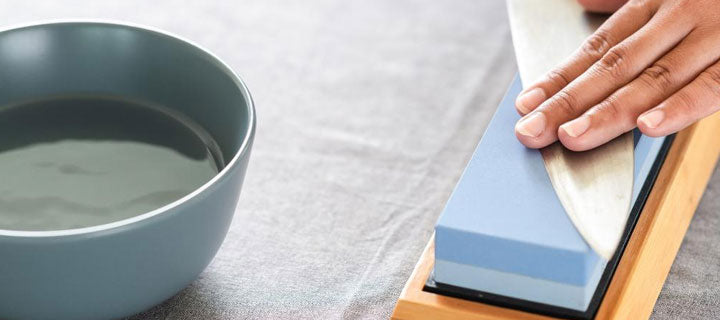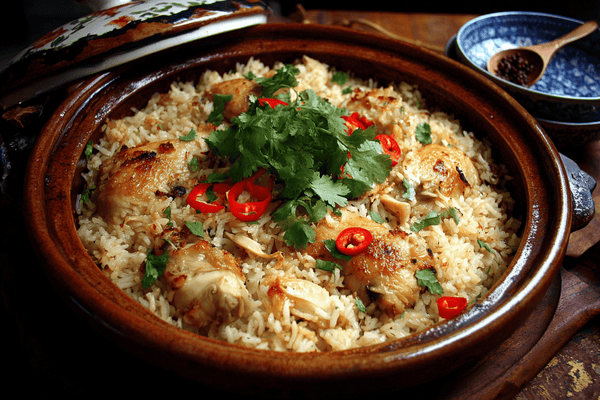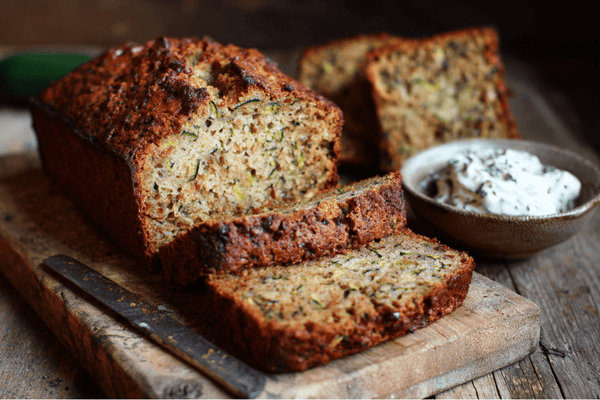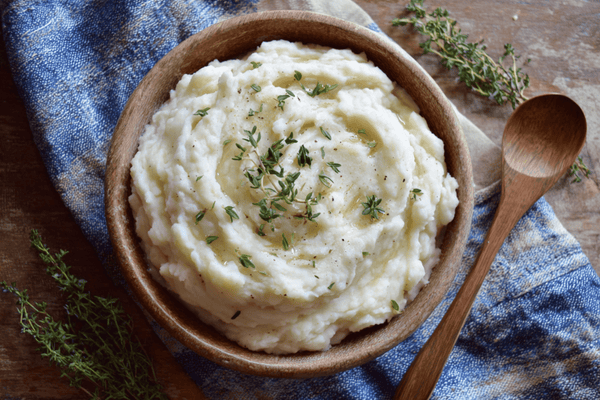
Having a razor sharp knife can quite literally be the difference between the blade passing effortlessly through food or slipping off and potentially causing an accident. Japanese chef knives are a work of art and are designed to be strong, tough, and sharp.
The sharpness, however, will depend on the angle at which you need to sharpen your knife as this is the sole determining factor as to how sharp your edge will be. The initial angle that the knife was designed with will determine this but how do you know what angle you need to keep your knives razor sharp?
The correct sharpening angle for the blade edge of the best Japanese knives is 10 - 15 degrees on one single side. On a one sided blade, or single bevel the angle would therefore be 10 - 15 degrees in total. Most Japanese knives are now double bevel meaning the blade needs to be sharpened to 10 - 15 degrees on the other side as well. For double bevel knives, the sharpening angle needs to be 20 - 30 degrees in total.
When it comes to the angle of a knife, the lower the angle, the sharper the blade and while Western blades (typically German manufactured) have a larger angle and therefore a thicker edge, Japanese knives have much thinner angles for a sharper edge which means more care needs to be taken when sharpening the straight edge on these fine angle knives.
If you are unsure of what angle you need to sharpen your Japanese knife with, how to sharpen a gyuto knife, and how to sharpen a katana with a whetstone, we are not only going to cover how you can sharpen the perfect edge in this article but also how you can do it consistently without needing to be a professional sharpener!
Table of contents
- Correct Japanese Knife Sharpening Angle
- How to Sharpen a Japanese Knife at the Correct Angle
- Finding the Correct Sharpening Angle
- Use a Sharpening Guide
- What to Use for Knife Sharpening
- Knife sharpening angle chart
- 15 vs 20 degree knife edge is there any difference?
- 3 Different Ways to Use a Whetstone, Should I Use My Sharpening Stones Wet or Dry?
- FAQ
- Round-Up
Correct Japanese Knife Sharpening Angle
For this article, we will assume that your Japanese knife is a standard chef’s knife. As there is such a range of knives for different cutting tasks (meat, bone joints, fish, filleting, fruit, and vegetables..) the angle of the bevel will vary drastically.
The standard Japanese chef’s knife is by far the most common knife used and the correct chefs knife angle is between 30 - 40 degrees.
We touched on this earlier but this degree is for both sides of the knife (bevel) combined. Most common knives are Western-inspired when it comes to the edge and are double bevelled meaning that the edge on either side of the blade is symmetrically creating a V edge. Therefore a 15-degree bevel on one side will mean that the sharpening angle for your knife is 30 degrees overall.
This is because both sides need to be sharpened to the same angle in order to maintain the fine edge. The exception to this is a single bevel knife.
With a single bevel knife (commonly used with traditional Japanese knives), one side of the blade is actually flat, this means that the single bevel side with a 15-degree angle will give a total sharpening angle of 15 degrees. This is an incredibly fine and sharp angle and with these knives, you will only sharpen the side with the bevel.
Traditional Japanese Knives will commonly have a single bevel edge however those that are manufactured by the Japanese for the Western world will have a double bevel edge which is why we use this as the baseline to work from.
If possible, we’d recommend referring to your exact product online (or if you kept the initial manual that came with the knife) to find the angle that it was machined to. If you can’t find this then don’t worry, you can still work out a good estimation for the angle and create a new one.
How to Sharpen a Japanese Knife at the Correct Angle
Sharpening dull knives is a skill that is well-worth mastering for any owner of kitchen knives to prolong the blades' longevity and precision. How to sharpen the sharp edge of butchers knives is much the same process as how to sharpen a paring knife. However the required angle for each different blade style can differ.
Unless you are a master chef or have significant kitchen experience, it’s highly unlikely that you have the level of skill, accuracy, and precision required to sharpen a Japanese knife at a consistent and correct angle with a Japanese knife sharpener.
When you take into consideration the level of attention and precision that goes into designing and creating a Japanese knife (a tradition of constant improvement with a focus on satisfying all the human senses), then it becomes easier to understand that you can’t take the sharpening process lightly.
Sharpening a Japanese knife is an art form in itself and to get started with the correct angle. For example, is the recommended butcher knife sharpening angle the same as that of a kiritsuke? We would always recommend that you first find out what angle you need to cut at in order to maintain the edge and secondly select something that can act as a guide.
Finding the Correct Sharpening Angle
Finding the proper angle to sharpen a knife can be quite tricky. If you have the manufacturer’s instructions or know the knife model then it’s going to be easy as you can just look up the manufactured angle and use this for reference.
If however, you don’t have this then you can use a laser (or normal) protractor to try and determine the angle. This could be a little tricky as the duller an edge gets, the more it will distort the angle measurement.
For most Japanese knives, a safe option is therefore to choose an angle between 15 - 20 degrees and use this to create your own 30 - 40-degree edge.
** remember, the angle of one side's bevel is not the edge angle, therefore if you want a 30-degree edge you will need to sharpen each side to 15 degrees.
You can also lie the blade as close to the tapered bevel as possible to replicate this original edge.
Use a Sharpening Guide
If you are skilled enough to maintain an angle by hand then this is excellent, for most people, however, an initial guide is useful in order to set your angle and have a visual guide. The most common way that people used this is through coins.
A 90-degree angle is when the knife edge is facing directly down, if you tilt the knife to create a 45-degree angle then most people can do this just by eye.
When you need to work with a typical 15-degree angle for a Japanese knife, however, then this becomes much more difficult for most people to measure just by eye alone and this is where coins are useful.
Two coins stacked on top of each other can typically add up to a 15-degree angle and this is therefore where you would position the back of the knife to set your angle. Using the coins gives a very easy, yet reliable method for sharpening a consistent angle on a Japanese knife yourself.

This would still be a rough estimate even when using coins and therefore to get the most accurate measurement we’d recommend measuring the angle needed, determining the distance that this would create from the spine of the blade to the whetstone (sharpening tool), and then using coins to fill in that required distance.
Alternatively you could use a DIY knife sharpening angle guide like in this image, one is included with every Whetstone Sharpening Stones by default.
What to Use for Knife Sharpening
There are many different types of knife sharpeners, including a manual sharpener, sharpening steel and electric knife sharpeners. The best method for sharpening a Japanese knife is to use a whetstone, these are the traditional methods used to sharpen a Japanese knife and it’s an incredibly satisfying experience to use one, particularly if you are new to knife sharpening.
Whetstones come in a variety of grades which are determined by the coarseness of the stone. These can range from #200 grit which is needed to reform and edge from a dull blade right the way through to a grit grade of #8000 which is ultrafine and used for precise refining and polishing of the edge.
Most Japanese knives will mostly need a grit grade of #200 - #3000 when sharpening an angle though this will depend entirely upon how dull your current knife is.
Our Japanese knife sharpener of choice would always be a whetstone. If you're looking for the best all-around size we recommend the 1000/6000 Whetstone Sharpening Stone.
Knife sharpening angle chart
Most Japanese knives are sharpened to between 15 and 20 degrees per side, with the majority being closer to the 15-degree mark. There are some knives that are sharpened below 10 degrees, but these are typically either very high-quality knives that will be used by professionals or extremely cheap knives that are not made to last.
Asian knife sharpening angles between 15 and 20 degrees will result in a 30 to 40-degree edge which is the standard for most Japanese knives. This edge will be incredibly sharp but will also need to be sharpened more frequently than a duller, yet more durable edge.
If you are unsure about what Asian knife sharpening angle to use then we recommend starting at 15 degrees and working your way up until you find the angle that works best for you.
Below is a mean average knife sharpening angle guides of what some of the top knives manufacturers recommend.
Chef Knife blade angle per side = 15 Degrees
Santoku knife blade angle per side = 14 Degrees
Paring Knife blade angle per side = 14 Degrees
Utility knife blade angle per side = 15 Degrees
Fillet knife blade angle per side = 16 Degrees
15 vs 20 degree knife edge is there any difference?
The main difference between a 15 and 20-degree knife edge is that the sharper 15-degree edge will dull quicker but will also be able to achieve a finer cut.
The 20-degree angle is a bit more durable but won’t be quite as sharp, it really comes down to personal preference and what you will be using the knife for as to which angle is better.
If you are looking for a general-purpose knife then we recommend going for the 20-degree option, but if you want a knife that is going to be able to handle more delicate tasks such as slicing fruits and vegetables then the 15-degree option might be better.
There really is no wrong answer when it comes to choosing between the two angles, it really comes down to what you are looking for in a knife.
3 Different Ways to Use a Whetstone, Should I Use My Sharpening Stones Wet or Dry?
Now that you know what to use to sharpen knives, it’s time to look at how to use it. There are three different ways to use a whetstone and each has its own advantages and disadvantages.
Dry Whetstone
The first way is to use the sharpening stone dry, without any lubrication. This is the traditional way of sharpening a Japanese knife and it has the advantage of not requiring any additional equipment.
The main disadvantage of using a whetstone dry is that it can be tough on the knife, particularly if you are using a lower gritstone. This can cause the blade to chip and damage the edge, making it more difficult to sharpen in the future.
If you are going to use a whetstone dry then we recommend using a higher grit stone (3000+) to minimize the risk of damaging the blade.
Water Whetstone
The second way to use a whetstone is with water. This is the most common way of sharpening a Japanese knife as it lubricates the stone and protects the blade from damage.
To use a whetstone with water you will need to soak the stone in water for around 10 minutes before use. Once it has been soaked, wet the blade of the knife and then start sharpening.
As the stone starts to dry out, add more water to keep it lubricated. Depending on the size of your stone, you may need to re-soak it a few times during the sharpening process.
Oil Whetstone
The third way to use a whetstone is with oil. This is not as common as using water but it has the advantage of not causing the stone to dry out as quickly.
To use a whetstone with oil, you will need to soak the stone in oil for around 10 minutes before use. Once it has been soaked, wet the blade of the knife and then start sharpening.
As the stone starts to dry out, add more oil to keep it lubricated. Depending on the size of your stone, you may need to re-soak it a few times during the sharpening process.
We have not included any guidelines on how to put a bevel on a knife by hand, as we would recommend asking an expert to carry out this procedure.
FAQ
Q- how to check knife sharpness?
The best way to tell if a knife is sharp is to try slicing a piece of paper.
If the knife can slice the paper cleanly then it is sharp. If the knife tears the paper or doesn’t cut through it then the blade is dull and needs to be sharpened.
Q - How to sharpen a sushi knife?
A: The best way to sharpen a sushi knife is with a whetstone. First, soak the stone in water for 10 minutes. Next, wet the blade of the knife and start sharpening. As the stone starts to dry out, add more water to keep it lubricated. we go into detail in this article.
Q - How often should I sharpen my Japanese knife?
A - A good rule of thumb is to sharpen the blade every month or so. This will ensure that it stays in top shape and doesn't get dull too quickly!
Q - Do you push or pull when sharpening a knife?
A - Well, there is no universal answer. Depending on the type of stone you are using and your personal preference will determine which direction will yield more success for this task. However, some people swear by pulling because they believe that pushing can cause too much pressure to be applied at one point in time whereas pulling leads to an even distribution over the length of blade being worked on during maintenance.
Q - Is 1000 grit whetstone enough?
A - The question has been answered by many, but the answer is always a resounding yes. The 1000 grit whetstone will give you all of the sharpness and polish that your blade needs to take on any hunting or fishing challenge with ease!
Q - How long does it take to sharpen a knife with Whetstone?
A - A Whetstone can take a few minutes to sharpen your knives. The process is simple and requires patience, along with the right honing stone grits for what you are sharpening. It only takes about 3-5 quick strokes on each side of the blade before it's ready to go again!
Q - Is it hard to sharpen a knife with a whetstone?
A - Sharpening your knives will become a lot easier with a little practice with the whetstone. With just a few steps and some patience, you can give old dull blades new life again! When it comes to cooking or carving up meat in the kitchen, nothing is more important than having sharp knives at hand. If time proves that you've neglected to sharpen them for too long though - don't worry! You won't have trouble getting those knife edges back into shape again.
Q - What is the best angle to sharpen a pocket knife?
A - Hunting and pocket knives that are used for cutting tougher materials will be sharpened to a recommended angle between 22 and 30 degrees.
Q - What about bread knives?
A - Serrated knives are quite a different beast when it comes to sharpening. We would recommend visiting our article on how best to sharpen serrated blades.
Q - How do I know if my knife is 15 or 20 degrees?
A - To determine the angle of a knife, you will need to use a protractor or angle finder tool. Place the blade of the knife on the protractor so that it is aligned with the angle markings on the tool. The angle of the blade will be indicated by the position of the protractor's arm. Keep in mind that the angle of a knife is measured from the edge of the blade, not the spine.
Round Up
The correct sharpening angle for a Japanese knife will vary slightly however the majority will need to be sharpened at 30 - 40 degrees, about 15 degrees on each side. The important thing to remember is that the sharpening angle is the entire angle taking into consideration the bevel angle on both sides of the blade.
The smaller the angle, the sharper the edge and while it might be tempting to try to sharpen a knife to a fine angle, it’s not recommended. Most Japanese knives strike a balance of strong, tough, and sharp edges, this is through years of honing their craft and combining ancient metalwork knowledge with cutting-edge technology.
This is the reason why Japanese knives are seen as the highest quality and a 30 - 40-degree angle for the edge helps to set this standard.


